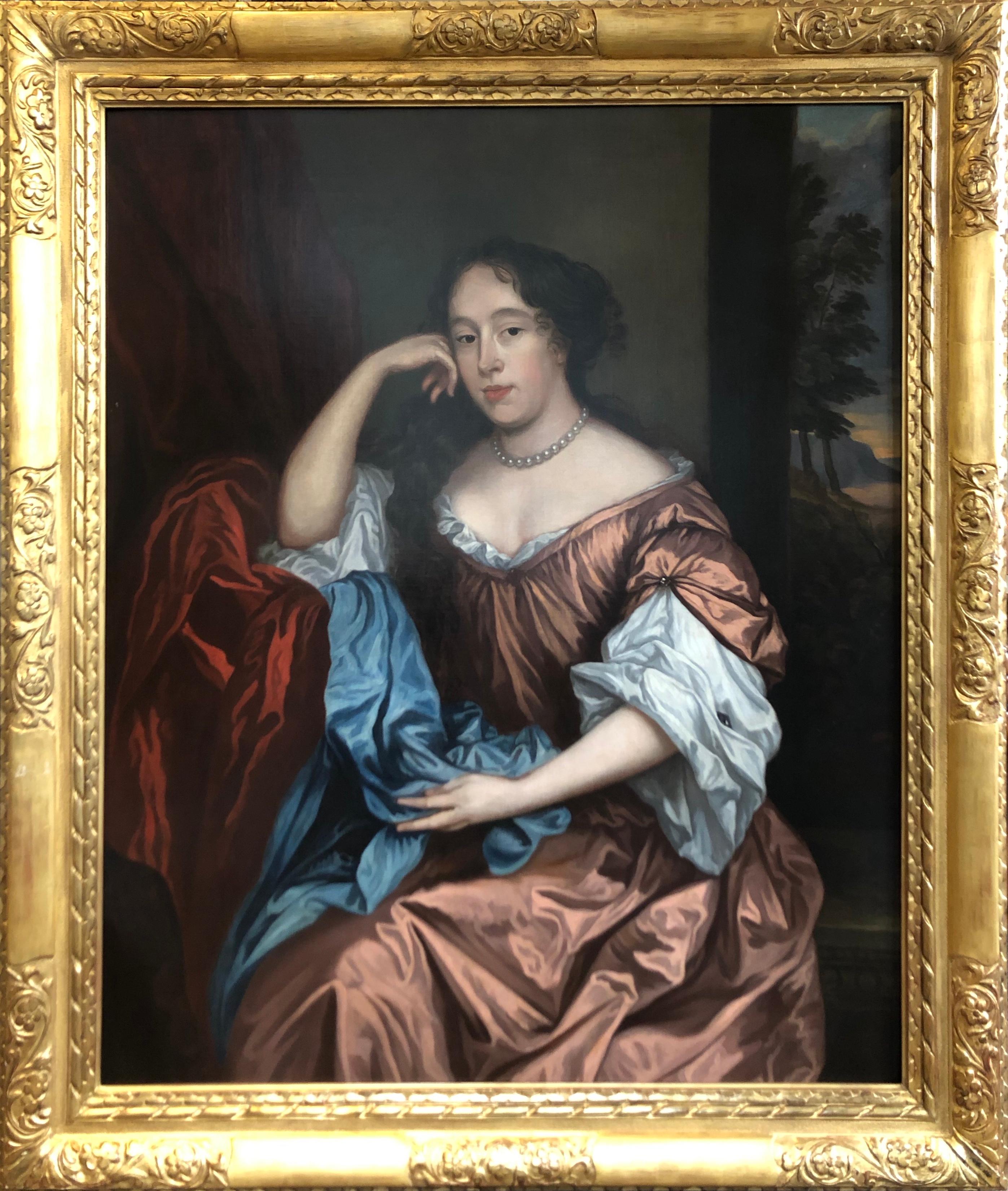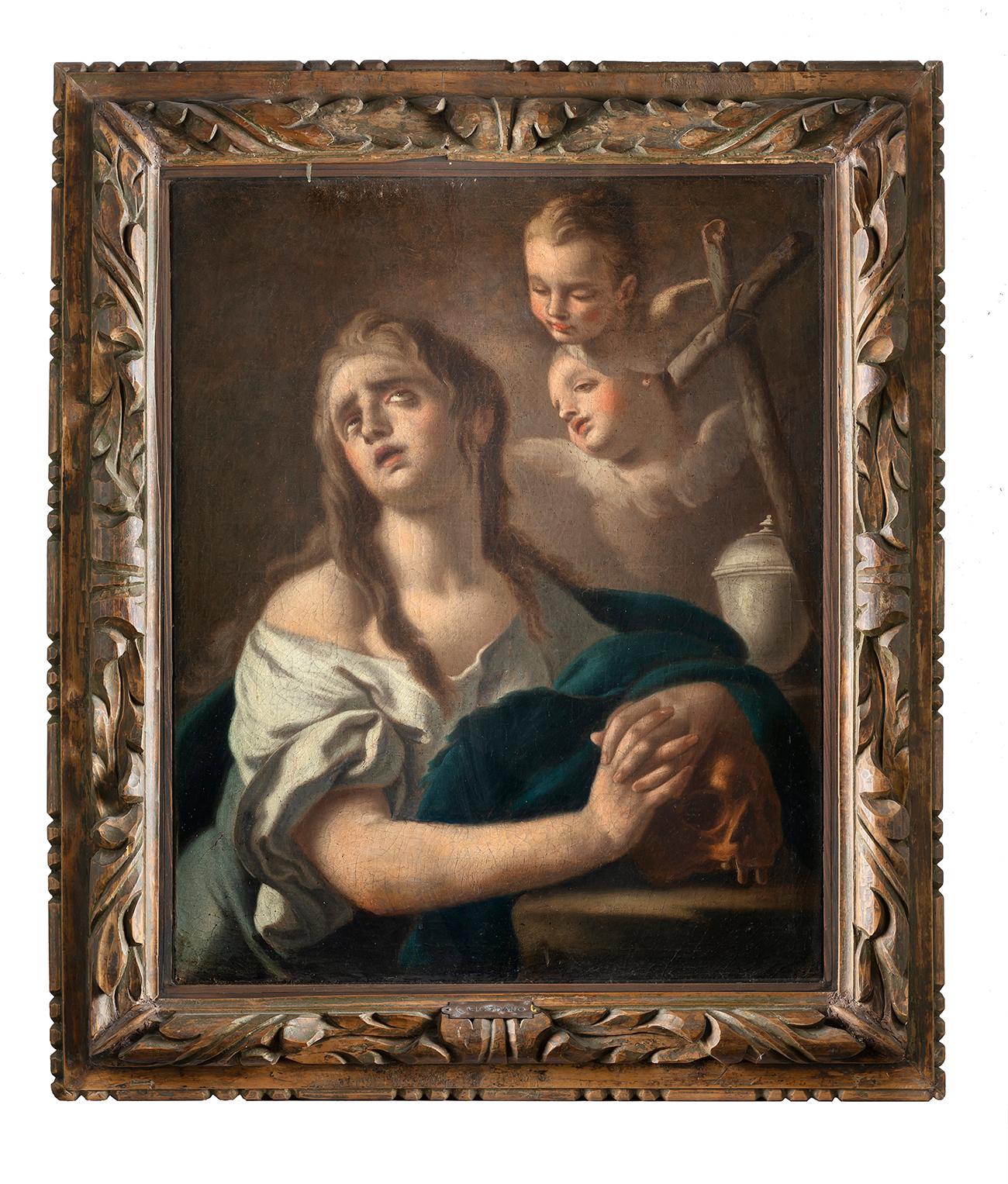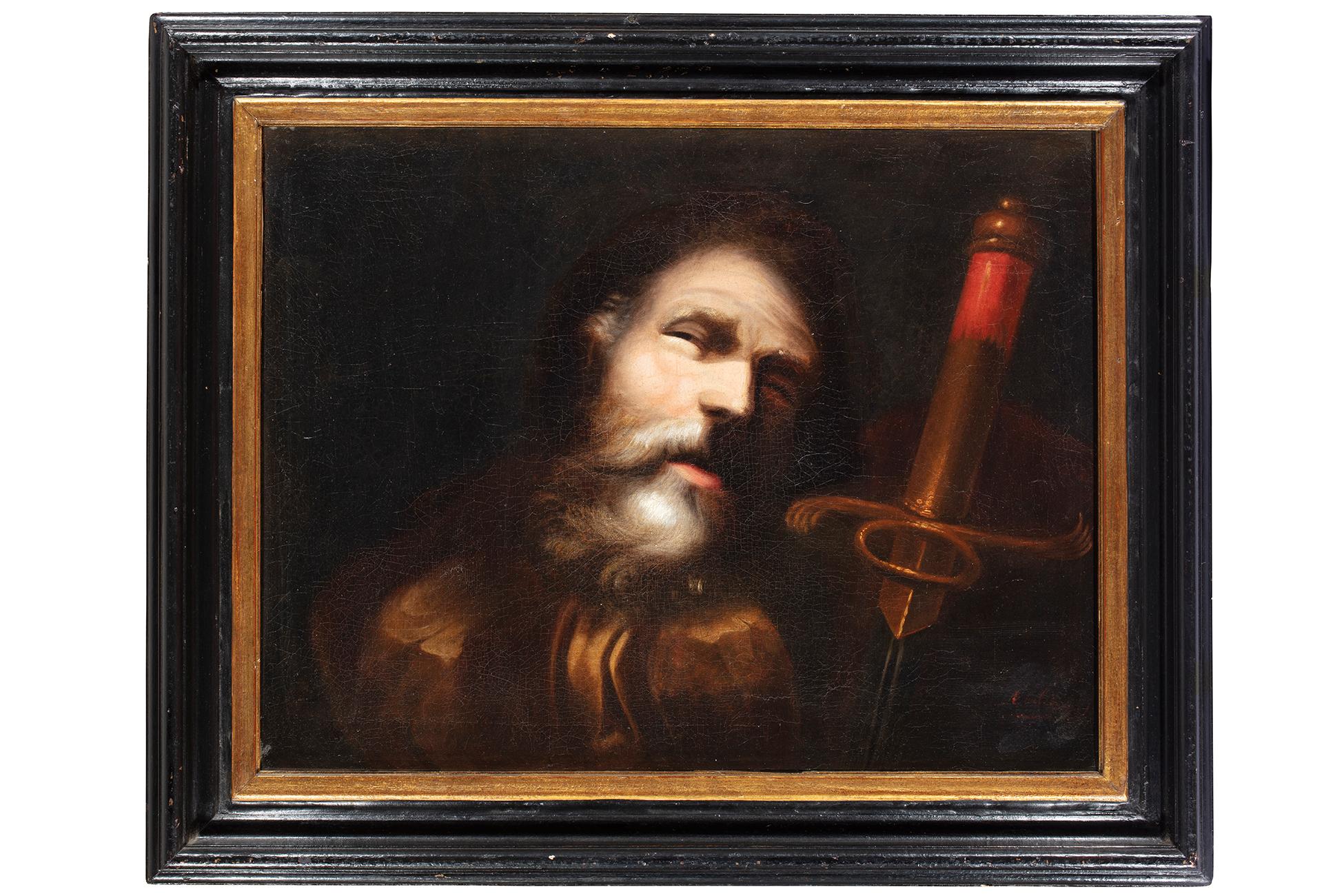Items Similar to The Annunciation to the Shepherds - Dutch 17thC art religious oil painting
Want more images or videos?
Request additional images or videos from the seller
1 of 14
Attributed to Benjamin Gerritsz Cuyp The Annunciation to the Shepherds - Dutch 17thC art religious oil painting Circa 1633
Circa 1633
About the Item
This wonderful 17th century Old Master religious oil painting is attributed to Dutch Golden Age artist Benjamin Gerritsz Cuyp. Painted circa 1633 it is entitled The Annunciation to the Shepherds. The figures of the shepherds are painted in muted tones with the focus being on The Holy Ghost and light shining down from the heavens. Even the sheep appear awe struck as they face the scene. A tremendous painting with overtones of Rembrandt.
Provenance. Wiltshire estate.
Condition. Oil on canvas, image size is 36 inches by 28 inches and in good condition for age and with an old patch repair.
Frame. Housed in a complementary 18th century carved gilt frame. Framed size is 42 inches by 34 inches and in good condition.
Benjamin Gerritszoon Cuyp (1612 – 1652) was a Dutch Golden Age landscape painter. Cuyp was born and died in Dordrecht. According to Houbraken he was a pupil of his uncle, Jacob Gerritsz Cuyp, who taught him together with his son (Benjamin's cousin) Aelbert Cuyp. Houbraken felt Aelbert had neater brush strokes and Benjamin showed the rough approach of his teacher. According to the RKD, Houbraken was mistaken about the family, and Benjamin and Jacob were both born in Dordrecht as the sons of a glasspainter from Venlo named Gerrit Gerritsz Cuyp. Benjamin learned to paint from his older half-brother, Jacob Gerritsz Cuyp. He was therefore the uncle, not the cousin, of the much more famous Aelbert Cuyp. He is known for allegorical pieces, genre works, beach scenes, military scenes, and landscapes. He influenced Barent van Kalraet, and was followed by Maerten Fransz van der Hulst.
- Creator:Attributed to Benjamin Gerritsz Cuyp
- Creation Year:Circa 1633
- Dimensions:Height: 34 in (86.36 cm)Width: 42 in (106.68 cm)Depth: 2 in (5.08 cm)
- Medium:
- Movement & Style:
- Period:
- Condition:
- Gallery Location:London, GB
- Reference Number:1stDibs: LU853113342442
About the Seller
5.0
Platinum Seller
These expertly vetted sellers are 1stDibs' most experienced sellers and are rated highest by our customers.
1stDibs seller since 2018
398 sales on 1stDibs
Typical response time: <1 hour
- ShippingRetrieving quote...Ships From: London, United Kingdom
- Return PolicyA return for this item may be initiated within 14 days of delivery.
More From This SellerView All
- The Gossip - Scottish 19thC art Victorian oil painting young romantic coupleBy William Fettes DouglasLocated in London, GBA fine Victorian Scottish genre oil on canvas painting which dates to 1868 and is titled The Gossip by famous Scottish artist William Fettes Douglas RSA. It is a stunning depiction o...Category
19th Century Victorian Figurative Paintings
MaterialsOil
- Portrait of a Lady with Pendant - British Art Deco 30's portrait oil paintingLocated in London, GBThis gorgeous Art Deco portrait oil painting is by British female artist Elsie March. Elsie was one of 9 siblings, eight of whom became artists. Although Elsie later went on to focus...Category
1930s Realist Portrait Paintings
MaterialsOil
- At the Foot of the Statue - Scottish art Impressionist figurative oil paintingBy William Strang, R.A., R.E.Located in London, GBA fine large oil painting by Scottish listed artist William Strang. This is a super evocative oil on canvas which depicts a family at "The Foot of the Statue". It was exhibited in 1904 in Bradford exhibition of fine arts lent by L W Hodson of Wolverhampton who was a patron of his work. This is a fine example of an early 20th century Scottish oil with good subject. It is a good size and signed. This wouldn't be out of place in Kelvingrove Gallery in Glasgow. Signed lower left. Provenance. Bradford Art Gallery 1904. Sotheby 19th June 2002 Guide price £20000-30000GBP. Condition. Oil on canvas. Image size 30 inches by 25 inches and in excellent condition. Housed in a fine period frame, 39 by 34 inches framed and in good condition. William Strang (1859-1921) was born at Dumbarton, the son of Peter Strang, builder, and educated at the Dumbarton Academy. He worked for fifteen months in the counting-house of a firm of shipbuilders before going to London in 1875 when he was sixteen. There he studied art under Alphonse Legros at the Slade School for six years. Strang became assistant master in the etching class, and had great success as an etcher. He was one of the original members of the Royal Society of Painter-Etchers, and his work was a part of their first exhibition in 1881. Some of his early plates were published in The Portfolio and other art magazines. He worked in many manners, etching, dry point, mezzotint, sand-ground mezzotint, and burin engraving. Lithography and wood-cutting were also used by him to create pictures. He cut a large wood engraving of a man ploughing, later published by the Art for Schools Association. A privately produced catalogue of his engraved work contained more than three hundred items. Amongst his earlier works were Tinkers, St. Jerome, A Woman Washing Her Feet, An Old Book-stall with a Man Lighting His Pipe from a Flare, and The Head of a Peasant Woman on sand-ground mezzotint. Later plates such as Hunger, The Bachelor's End and The Salvation Army were also important. Some of his best etchings were done as series—one of the earliest, illustrating poet William Nicholson's Ballad of Aken Drum, is remarkable for clear, delicate workmanship in the shadow tones, showing great skill and power over his materials, and for strong drawing. Another praised series was The Pilgrim's Progress, revealing austere sympathy with John Bunyan's teaching. Samuel Taylor Coleridge's Ancient Mariner and Strang's own Allegory of Death and The Plowman's Wife, have served him with suitable imaginative subjects. Some of Rudyard Kipling's stories were also illustrated by him, and his likeness of Kipling was one of his most successful portrait plates. Other etched portraits included those of Ernest Sichel and of J.B. Clark, with whom Strang collaborated in illustrating Baron Munchausen...Category
Early 1900s Impressionist Figurative Paintings
MaterialsOil
- Two Women in a Cafe - British 1930's art oil portrait painting Spain jugs pinkBy Darsie JappLocated in London, GBAn original oil on canvas by the British listed artist Darsie Japp. It was painted circa 1930 and depicts two woman at a table having a drink. A very evocative inter war oil painting...Category
1910s Impressionist Figurative Paintings
MaterialsOil
- Death of the Young Men 1938 - British art figurative Surrealist oil paintingBy Jack SassoonLocated in London, GBAn oil on canvas painted by Jack Sassoon which was certainly a premonition of what was to come. Entitled Death of the Young Men and dated 1938, it depicts men in gas masks and a woma...Category
1930s Surrealist Figurative Paintings
MaterialsOil
- Portrait of Lady Ruthven - Edwardian Society British American art oil paintingBy James Jebusa ShannonLocated in London, GBAn original oil on canvas by Sir James Jebusa Shannon. The painting depicts Lady Ruthven in a stunning silk and lace dress. It dates to the Edwardian period and depicts a bold Britis...Category
20th Century Realist Portrait Paintings
MaterialsOil
You May Also Like
- Portrait of a Lady, After Sir Peter Lely (1610-1680) Oil PaintingBy After Sir Peter LelyLocated in Uppingham, GBOil Painting After Sir Peter Lely (1610-1680) Portrait of a Lady Housed in a Lely gold Leaf Frame. Peter Lely: In 1647 he became a member of the Pain...Category
17th Century Old Masters Portrait Paintings
MaterialsOil
- Portrait of Jean-Baptiste Greuze, painted on linen by his daughter Anna GreuzeLocated in PARIS, FRThis replica of the last self-portrait of Jean-Baptiste Greuze painted in 1804, executed by his daughter Anna at her father's side and recently rediscovered, provides us with a poignant image of the great artist, represented with panache despite the disillusions of life. 1. Jean-Baptiste Greuze Jean-Baptiste Greuze was the sixth child of a roofer from Tournus and retained a certain rusticity in his behaviour from his provincial childhood, beyond his taste for describing picturesque scenes of the countryside. He initially started training with a little-known painter from Lyon, Charles Grandon, before his genius was recognised in Paris where he became a full-time student of the Académie (of Painting) in 1755. He exhibited his work for the first time at the Salon during the summer of 1755, before leaving on a trip to Italy in the company of Louis Gougenot, abbot of Chezal-Benoît. Upon his return to Paris, Greuze became a prolific painter, participating widely in the Salons held between 1759 and 1765, to which he sent no less than 63 paintings: numerous genre scenes (The Marriage Contract, The Beloved Mother), but also portraits of his family circle, of courtiers and art lovers, or of his colleagues. The Academy closed the doors of the Salons to him in 1767 for not having produced his reception piece within six months of his reception, as was the tradition. He worked actively on this painting (Emperor Severus rebukes Caracalla, his son, for trying to assassinate him ) until the summer of 1769, tackling historical and mythological subjects for the first time. Once this was completed, he was then fully admitted to the Academy, but as a genre painter, and not as an historical painter, which had been one of the greatest humiliations of his life. Greuze then refused any participation in events organised by the Academy or its successor, the Academy of Fine Arts until 1800. Abandoning history painting, he gave a new twist to genre scenes, bringing them closer to history painting, as in this pair of canvases which constitutes some of his masterpieces: The Paternal Curse: The Ungrateful Son and The Paternal Curse: The Punished Son . Married in 1759 to Anne-Gabrielle Babuti, the daughter of a Parisian bookseller, his marriage was unhappy and his wife probably frequently unfaithful. The institution of divorce enabled him to record their separation in 1793, keeping his two daughters Anna-Geneviève, born in April 1762, and Louise-Gabrielle, born in May 1764, with him. Little is known about his daughter Anna except that she was herself a painter and lived with her father until his death. It is likely that most of the paintings she produced up to that date were attributed to her father, whose technique she shared to a great extent, making it extremely difficult to establish an autonomous corpus of her paintings. Greuze died in his studio at the Louvre on March 21st 1805. The attention paid to the expressivity of his characters and the emotional charge they convey enabled Jean-Baptiste Greuze to enjoy immense popularity with the eighteenth-century public, and they still constitute Greuze's true modernity. As the artist said, "I dipped my brush in my heart". Greuze was also an exceptional draughtsman and a portraitist of immense talent and exceptional longevity who painted both the Dauphin (the son of Louis XV and father to Louis XVI) and the young Napoleon Bonaparte. 2. Greuze's self-portraits Greuze was very much influenced by Dutch paintings during all his life. While the source of his inspiration for genre scenes can be found in Gerard Dou...Category
Early 1800s Old Masters Portrait Paintings
MaterialsLinen, Oil
- 18th Century by Pietro Bardellino Mary Magdalene Painting Oil on CanvasBy Pietro BardellinoLocated in Milano, LombardiaPietro Bardellino (Naples, 1731 – Naples, 1806) Mary Magdalene Oil on canvas, cm. 75 x 60 – with frame cm. 97 x 82 Antique shaped and carved wooden frame Publications: unpublished T...Category
Mid-18th Century Old Masters Portrait Paintings
MaterialsCanvas, Oil
- 17th Century by Giuseppe Assereto Portrait of an Elderly Woman Oil on CanvasBy Giuseppe AsseretoLocated in Milano, LombardiaGiuseppe Assereto (Genova - 1626 ca – Genova 1656/57) Portrait of an elderly woman, possible portrait of Maddalena Massone, wife of Gioacchino Assereto Oil on canvas, cm. 65,5 x 51,5...Category
Early 17th Century Old Masters Portrait Paintings
MaterialsCanvas, Oil
- 17th Century by Juan Alfonso Abril Head of St Paul Painting Oil on CanvasLocated in Milano, LombardiaJuan Alfonso Abril (active in the 17th century in Valladolid) Head of Saint Paul Oil on canvas, cm. 48,5 x 62 - with frame cm. 63 x 76,5 Shaped wooden f...Category
Early 17th Century Old Masters Figurative Paintings
MaterialsCanvas, Oil
- 17th Century by Giovanni Battista Beinaschi Saint Bartholomew Oil on CanvasBy Giovanni Battista BeinaschiLocated in Milano, LombardiaGiovan Battista Beinaschi (Fossano, 1636 - Naples 1688) Saint Bartholomew Oil on canvas, cm. 96 x 71,5 – with frame cm. 108 x 86 Shaped and gilded ...Category
Mid-17th Century Old Masters Portrait Paintings
MaterialsCanvas, Oil





